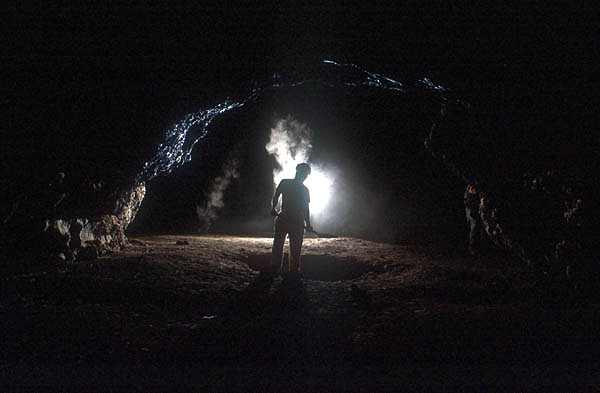New Publication
THE HIBASHI REPORT
Photos
by J. Pint unless otherwise indicated - Photos ©2006 by John and Susy Pint-- Updated September, 2013
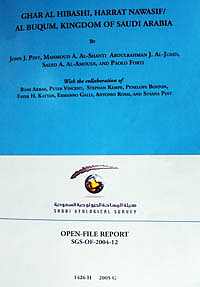 Ghar
al Hibashi Harrat Nawasif/Al Buqum, Kingdom of Saudi Arabia
by J.J. Pint, M.A. Al-Shanti, A.J. Al-Juaid, S.A. Al-Amoudi and P. Forti, with
the collaboration of R. Akbar, P. Vincent, S. Kempe, P. Boston, F.H. Kattan, E.
Galli, A. Rossi, and S. Pint, SGS-OF-2004-12, Saudi Geological Survey, Jeddah,
Saudi Arabia, 2005, 68 p. 43 figs, 1 table., 2 apps., 1 plate.
Ghar
al Hibashi Harrat Nawasif/Al Buqum, Kingdom of Saudi Arabia
by J.J. Pint, M.A. Al-Shanti, A.J. Al-Juaid, S.A. Al-Amoudi and P. Forti, with
the collaboration of R. Akbar, P. Vincent, S. Kempe, P. Boston, F.H. Kattan, E.
Galli, A. Rossi, and S. Pint, SGS-OF-2004-12, Saudi Geological Survey, Jeddah,
Saudi Arabia, 2005, 68 p. 43 figs, 1 table., 2 apps., 1 plate.
In
2004, Hibashi Cave was added to the list of the ten mineralogically most
important lava caves in the world. This is rather extraordinary because prior to
2001, no scientific cave studies had been carried out in Saudi Arabia’s vast
lava fields, whereas, elsewhere on the planet, lava caves have been under study
for centuries. A possible implication is that Saudi Arabia may possess a large
number of lava caves of importance to more than one field of scientific study.
This assumption is bolstered by the publication in 2005, of a new report on
Hibashi Cave, based on explorations
which began in January of 2003.
The Hibashi Report is available in printed form from
Saudi Geological Survey. However, the complete report (or just the abstract in English or Arabic)
can be downloaded from the internet.
The
new report comes only three years after
the Kishb Report which describes
the first mapping of lava tubes in Saudi Arabia as well as the discovery of
possibly Neolithic structures and artifacts in several caves.
| The
Hibashi Report includes a large (60X88 cm) plate showing plan and profile maps
of the cave, which is 689.54 meters long with a vertical difference of 25
meters.
John Pint displaying the Hibashi Map at the
2005 NSS Convention. Click on the picture to see the entire map in detail (.PNG
file, 307 kb). Photo by Susy Pint.
|
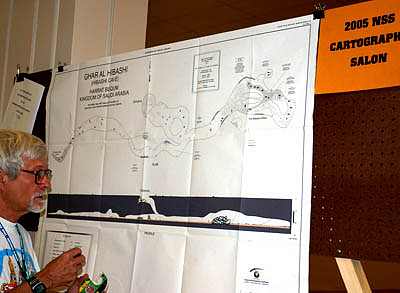 |
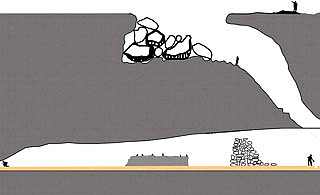 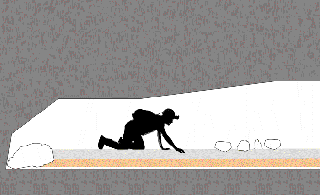
The
profile view is especially useful for appreciating the features of the cave in
perspective... |
The
grey area represents one of two burnt-guano beds found in the cave. Combustion
from these guano fires aided in the production of minerals such as pyrocroproite
and pyrophosphite, which are rarely found in caves. Professor Paolo Forti, one
of the co-authors of the report, lists nineteen cave minerals detected in
samples from Hibashi cave and provides eighteen images of the most interesting
minerals, taken through an electron scanning microscope. A popular treatment of
Prof. Forti’s analyses can be found at
http://www.saudicaves.com/minerals/index.html .
|
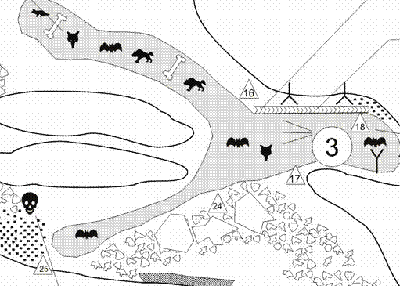 |
|
Features of the cave include lava stalactites, stalagmites, levées, gutters and
a 13-meter-long inclined lava channel.
Lava channel, now filled with dirt from
surface and unburnt bat guano. Pen shows scale.
|
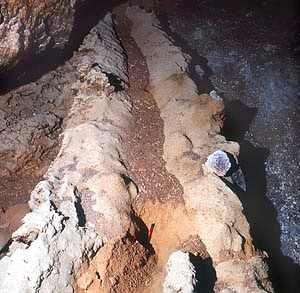 |
| A bed
of thick, powdery silt up to 1.5 meters deep covers the floor of the cave.
Samples of this silt were taken from the cave and age-dated using Optically
Stimulated Luminescence (OSL). Silt or loess taken from a depth of 150 cm
proved to be 5.8±0.5 ka: nearly 6,000 years old. This
bed of loess attracted the attention of researchers involved in a project funded
by the NASA Institute for Advanced Concepts. They are designing microrobotic
technology for underground exploration using Hibashi Cave as a model for Martian
Lava Tubes.
Mahmoud Al-Shanti measures
the depth of the loess bed in Hibashi Cave.
|
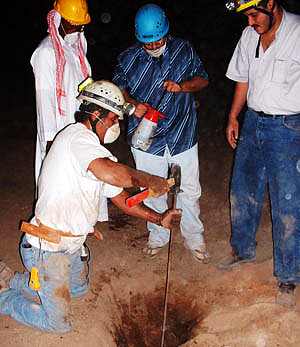 |
|

Unidentified bones of large and small animals are found in many parts of the
cave, apparently carried inside by hyenas, foxes and wolves. Appendix One of the
report describes the desiccated scat of these animals, which is so well
preserved that it is possible to extract phytoliths (tiny particles of opal with
unique shapes) from the plant material they contain. The authors note that the
cave-map symbol for guano approved by the UIS and used throughout the world is
inadequate to represent the several kinds of animal scat found in most desert
caves. They retain a bat symbol for bat guano and introduce five additional
symbols for the droppings of wolves, hyenas, foxes, birds and sheep or goats,
noting that the location of various kinds of animal scat is of interest not only
to speleobiologists, but to anyone exploring these caves, due to the usefulness
of scat deposits as landmarks.
|
|
Appendix Two of the report describes a human skull probably belonging to a girl
12-14 years of age and found deep inside the cave. The upper portion of the
skull appears to have been removed by a sword or axe. Carbon dating indicates it
is 425 ±30 years old. It should be noted that the skull was found lying on the
surface of the thick bed of silt covering the cave floor and that no attempt has
yet been made to dig below the surface for other remains or artifacts.
Side view of skull found in
Hibashi Cave.
|
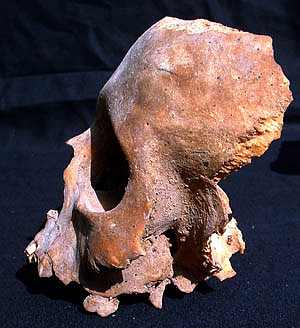 |
The
studies carried out in Hibashi Cave—when taken together with the results of the
expeditions to the caves of Harrat Kishb—suggest that the lava tubes of Saudi
Arabia are likely to be fertile ground for important new discoveries in the
future.
 Ghar
al Hibashi Harrat Nawasif/Al Buqum, Kingdom of Saudi Arabia
by J.J. Pint, M.A. Al-Shanti, A.J. Al-Juaid, S.A. Al-Amoudi and P. Forti, with
the collaboration of R. Akbar, P. Vincent, S. Kempe, P. Boston, F.H. Kattan, E.
Galli, A. Rossi, and S. Pint, SGS-OF-2004-12, Saudi Geological Survey, Jeddah,
Saudi Arabia, 2005, 68 p. 43 figs, 1 table., 2 apps., 1 plate.
Ghar
al Hibashi Harrat Nawasif/Al Buqum, Kingdom of Saudi Arabia
by J.J. Pint, M.A. Al-Shanti, A.J. Al-Juaid, S.A. Al-Amoudi and P. Forti, with
the collaboration of R. Akbar, P. Vincent, S. Kempe, P. Boston, F.H. Kattan, E.
Galli, A. Rossi, and S. Pint, SGS-OF-2004-12, Saudi Geological Survey, Jeddah,
Saudi Arabia, 2005, 68 p. 43 figs, 1 table., 2 apps., 1 plate.







